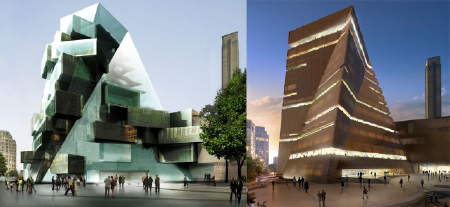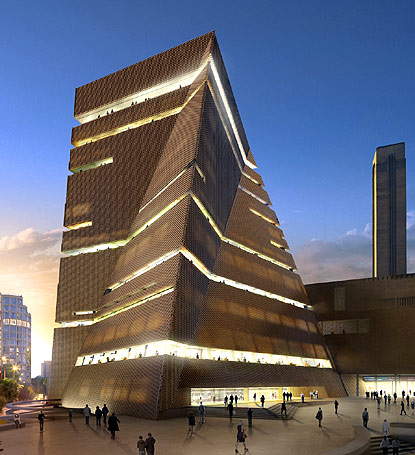Tate Modern extension swaps glass for brick
Revised designs for the extension of Tate Modern were revealed on Friday with the planned glass cubes replaced with a brick lattice that more closely relates to Bankside Power Station.


Tate still hopes to complete the 11-storey extension by Herzog and de Meuron – the Swiss architects who converted Bankside Power Station into the hugely successful modern art gallery – by 2012.
The building will include more varied spaces for Tate's growing collection and better facilities for the gallery's education programmes, as well as a rooftop terrace with views of St Paul's Cathedral.
The extension will add an additional 21,500 sq m to Tate Modern's existing 35,000 sq m.
At the launch event for the new designs Tate director Sir Nicholas Serota reminded guests that one-third of the former power station building remains unused.
Sir Nicholas said that when Tate took on Bankside Power Station in 1995 it always intended to develop the building in two phases. It was originally envisaged that the second phase would be built around 2020 or 2025, but the huge success of the gallery made it necessary to bring forward the expansion of visitor facilities.
Parts of the building are still in use by electricity firm EDF Energy, but changes in technology mean that they can now use smaller transformers freeing up more space for use by Tate.
The gallery boss explained that very little work had been done on the designs for Tate Modern 2 between July 2006 and January 2008. The key changes in the latest proposals are the incorporation of the former oil tanks below the south-west lawn into the gallery and the change from glass cladding to a more energy-efficient brick latticework.
Sir Nicholas believes that the new design "sits much more comfortably" with the Giles Gilbert Scott-designed power station.
"This is clearly a building that has been designed for a particular place," he added, explaining that Tate was keen that their new building should appear distinct from the nearby commercial developments in the Bankside area.
The outline of the three oil tanks will be expressed in the layout of the new piazza which will link a new southern entrance to the turbine hall with the pedestrianised Canvey Street shopping area.
Pedestrians will be able to use the Turbine Hall bridge 12 hours a day as a convenient link between Sumner Street and the Millennium Bridge.
The new designs mean that Tate must seek fresh planning permission from Southwark Council. Earlier this year Southwark planning officer Adrian Dennis admitted that the original extension design had been fast-tracked through the planning process because of the prestige Tate brings to the borough.
"Had it been a speculative office block, we'd have told them, 'You're not ready'", Dennis told Building Design magazine. "It wasn't as thoroughly worked up as we'd have liked, although there was enough information to allow the planning committee to know what to expect."
Tate has so far raised £67 million of the £215 million (at 2012 prices) cost of the extension, including £50 million from central government.
If the current fundraising drive is successful, construction work could start this time next year – although Sir Nicholas concedes that this is "probably the most challenging time to raise money in the past 25 years".
Comments
What do you think of the new design?
Join the discussion right nowShare
The SE1 website is supported by people like you
More to read
- Tate Modern to fit balustrade to deter visitors from scaling wall 24 Sep 2016
- Tate Modern extension will open on Friday 17 June 2016 25 Sep 2015
- Tate Modern's oil tanks to open for 15-week summer festival 23 Apr 2012
- Be among the first to see Tate Modern's new building - in Bermondsey 4 Oct 2010
- Fundraising for Tate Modern extension reaches half-way point 9 Sep 2010
- Watch Tate Modern's extension take shape on new Bankside webcam 25 Feb 2010
- Boris Johnson starts enabling works for Tate Modern extension 6 Jan 2010
- Work to strengthen Tate Modern Turbine Hall foundations begins 13 Nov 2009
- Tate Modern extension gets green light from Southwark councillors 1 Apr 2009
- Details emerge of 'Three Houses' skyscrapers at London Bridge 8 Mar 2009
Follow us
Email newsletter
For the latest local news and events direct to your inbox every Monday, you need our weekly email newsletter SE1 Direct.

